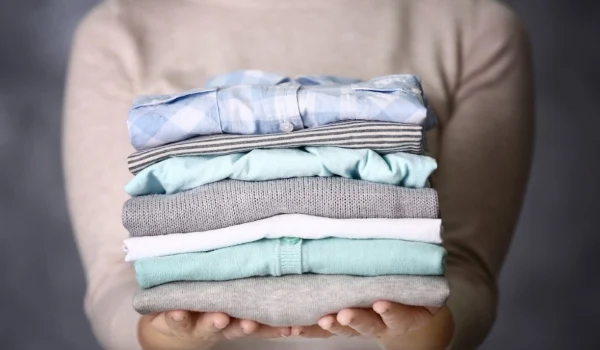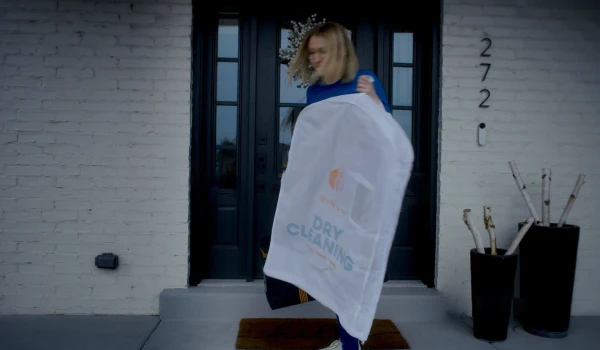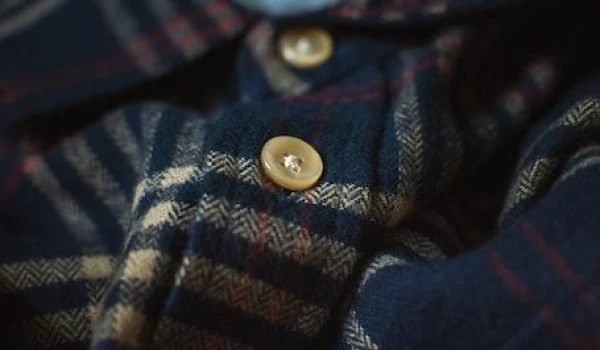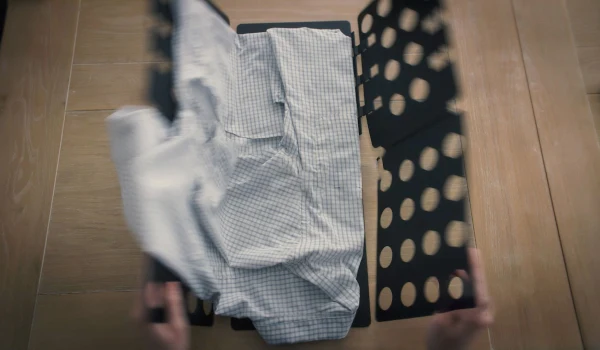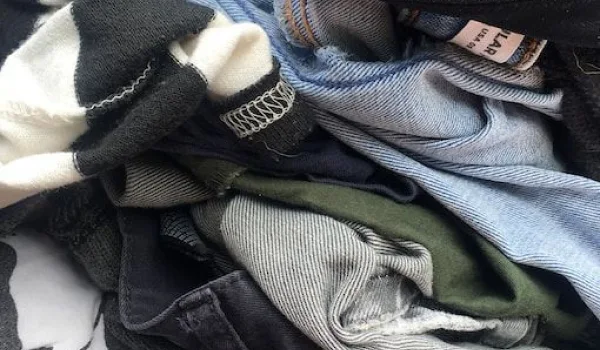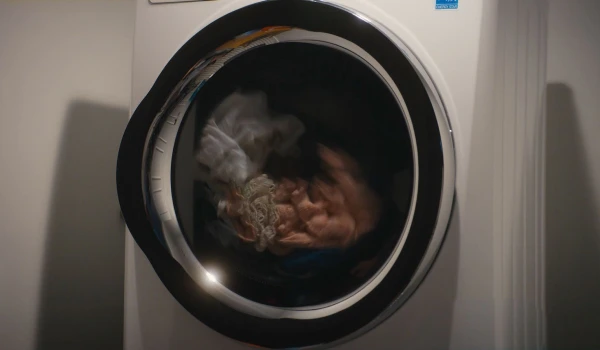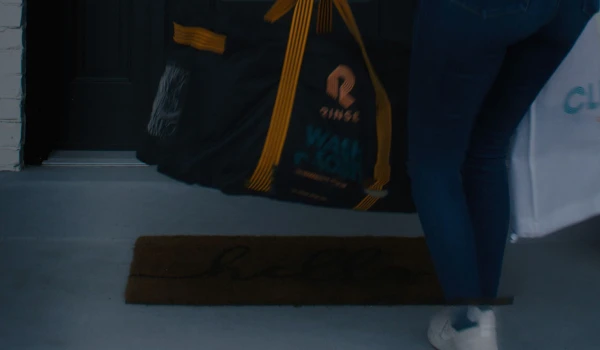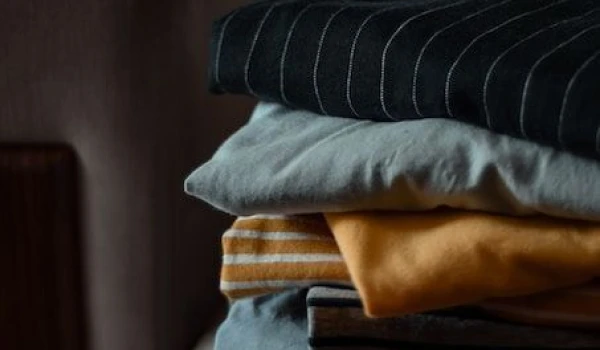Time
Hacks and how-to guides to make life easier.

In a world where time is precious, discover how to simplify your life by implementing simple laundry tips to make your routine more efficient and stress-free. Embrace and enjoy a hassle-free laundry experience that gives you more time for what truly matters with Rinse!
Usual Problems With Laundry
Laundry is a part of our routine, but many of us may unknowingly make it more challenging and time-consuming than necessary. In this section, we'll discuss common problems and misconceptions people encounter in their laundry rituals and how practical tips can transform this chore.
-
Not Having an Established Laundry System: Lack of a structured laundry routine can result in chaos. Sorting clothes, knowing which ones need special care like hand washing, and finding the right laundry products can be daunting without a system. Simplify your laundry by creating a laundry schedule, designating sorting bins for whites, darks, and delicates, and ensuring you have the right detergent and stain remover. Having a clear system in place makes the process smoother and more efficient.
-
Negative Thinking Around Laundry: Sometimes, the mental burden associated with laundry can make it feel more challenging than it is. If you approach it with dread, you're more likely to procrastinate. To shift your perspective, consider laundry a simple, satisfying task.
-
Overlooking the Convenience of Mesh Laundry Bags: Mesh laundry bags are an unsung hero in the laundry world. They are fantastic for keeping small items, like socks and lingerie, from disappearing into the laundry abyss. Sorting laundry using these bags is a time-saver, preventing tangling and keeping your items in excellent condition.

7 Laundry Tips to Simplify Your Life
Do you ever feel like your laundry routine consumes too much time and adds unnecessary stress? If so, you're not alone. The good news is there are effective ways to simplify your laundry process and make it more efficient, leaving you with more time for what truly matters. Below, we've compiled a list of seven invaluable laundry tips and tricks that will transform your washing routine into a breeze, reducing stress and giving you more time to enjoy life.
1. Plan your week
Planning your week is one of the most effective ways to simplify your laundry routine. Take a moment to create a laundry schedule that aligns with your lifestyle. Consider the number of laundry loads, specific laundry days, and the timing that suits you best. Having a clear plan will prevent last-minute laundry chaos and allow you to enjoy more of your week stress-free.
2. Consider doing small loads throughout the week
When it comes to efficient laundry management, one strategy that can significantly simplify your life is breaking your laundry routine into smaller loads distributed throughout the week. This approach offers several advantages over the traditional weekend laundry marathon and can streamline your entire process.
-
Reduced Wrinkling: With smaller loads, your clothes have more room to move in the washer and dryer, reducing the chances of heavy wrinkling. This results in less time spent ironing or dealing with wrinkled clothes.
-
Gentler on Delicates: Delicate fabrics and clothing items often require special care. Smaller loads allow you to give delicate items the attention they need, whether handwashing, air drying, or a gentler cycle.
-
Less Sorting: Smaller, more frequent loads can streamline your sorting process. You may even be able to skip sorting altogether for certain loads, such as dedicated loads for delicates or whites.
-
Reduced Workload: Laundry can often feel daunting when saved for the weekend. Smaller, regular loads feel more manageable and can reduce the sense of being overwhelmed.
3. Hire a laundry service
The ultimate solution to simplify your life and make laundry effortless is outsourcing it to a professional laundry service. Imagine a scenario where you never have to worry about sorting, washing, or folding your clothes again. Professional laundry services offer precisely that level of convenience. Here's how hiring a laundry service can streamline your life:
-
Reduced Hassle: No more work with separating delicates, figuring out the right water temperature, or dealing with stubborn stains. Laundry professionals care for everything, ensuring your clothes are returned clean and fresh.
-
Eco-Friendly Practices: Many laundry services now use eco-friendly detergents and practices, reducing your environmental footprint while keeping your clothes clean.
-
Customized Care: Laundry services can handle specific requests, such as air drying delicate items or using certain detergents for sensitive skin.
Additional Services: Besides traditional laundry, many services offer dryer sheets, mesh bags for delicates, stain removal, and even dryer balls to keep your clothes soft and static-free.
4. Designate hampers, baskets, or even drop-off spots
One of the keys to efficient laundry is organization. By designating hampers, baskets, or drop-off spots within your home, you can simplify the process, reduce clutter, and ensure that your laundry routine flows seamlessly. Here's how this approach can help:
-
Dirty Clothes Hamper: Have a dedicated hamper or bin for dirty laundry. Place it strategically in your home, such as in the bathroom or bedroom, to encourage family members to toss their dirty clothes there. This helps prevent clothes from piling up around the house.
-
Urgent Laundry Spot: Designate a small area for urgent laundry. This can be a small basket or shelf for items that need immediate attention, like a stain that requires treatment. Having a designated spot helps you deal with issues promptly.
-
Clean and Folded Area: Allocate a space for clean, folded clothes. It can be a shelf, a drawer, or even specific hooks or hangers. This ensures that clean clothes don't get mixed up with dirty ones.
5. Use the 'Delay' button on your washer
Many modern washing machines come with a Delay function, a fantastic feature that can help you take control of your laundry schedule. Here's how it works and why you should consider using it:
-
Convenience: The Delay button allows you to preset the start time for your washing machine. This means you can load your washer in the evening, for example, and set it to start the cycle early in the morning, right before you wake up. It's like having a laundry fairy that works while you sleep!
-
Energy Efficiency: By scheduling your laundry at times when energy costs are lower or when your household is using less power, you save on electricity bills. This is not only convenient but also environmentally friendly.
-
No Rush: You can avoid the rush to complete laundry in the morning or before you leave for work. Instead, you can enjoy a leisurely morning routine while your washing machine does the work.
6. Determine what’s too soon to wash
We often toss clothes into the laundry basket without much thought, believing that washing them as soon as possible is the right approach. However, not everything needs immediate cleaning. Here are some examples of what's too soon to wash:
-
Jeans: Denim items, like your favorite pair of jeans, don't require frequent washing. Washing them too often can lead to fading and wear. Instead, consider spot-cleaning or using a fabric freshener between washes. Jeans can be worn multiple times before they truly need a wash.
-
Outerwear: Coats and jackets often don't need frequent cleaning, as they are a barrier between your clothing and the outside world. Unless visibly soiled or emitting an unpleasant odor, outerwear can be worn several times before requiring a wash.
-
Towels: Towels are used to dry clean bodies, so they should be relatively clean. Allow them to dry properly after use, and you can use them multiple times before needing to toss them into the laundry.
7. Use a timer
Managing laundry tasks efficiently can sometimes be challenging, especially when dealing with a busy schedule. Using a timer is helpful to stay on top of your laundry routine. Here's how you can make it work for you:
-
Laundry Batching: Set a timer to remind yourself when to check on your laundry. This prevents you from forgetting loads in the washer or dryer.
-
Folding and Putting Away: If you tend to leave clean clothes in a basket for days, set a timer to dedicate a specific time each day to fold and put away your laundry. This ensures that your clothes remain wrinkle-free and ready to wear.
-
Stain Treatment: For tough stains that need pre-treatment, set a timer to remind yourself to address them before tossing the garment into the washing machine. Timely stain treatment can significantly improve stain removal.

Make Laundry a Breeze
Optimizing your daily chores is essential in a fast-paced world where every moment counts. Trying the aforementioned 7 time-saving tips can transform your laundry routine into a simplified, stress-free task, allowing you more time to focus on what truly matters.
When it comes to point 3, consider Rinse for your professional laundry and dry cleaning service needs. We pick up and deliver straight to your door, 7 days a week. You can rest easy knowing your clothes will be cleaned with the highest standards, leaving you more time for the things you love.
Contact us at Rinse today to see our skill in action.

Are you ready to embrace sustainability in your daily life and make a positive environmental impact from home? This resource encompasses a wide spectrum of eco-conscious practices that you can implement at home, including energy-efficient improvements, water conservation techniques, waste reduction strategies, savvy sustainable shopping advice, and tips for adopting eco-friendly eating habits. Dive into a more sustainable lifestyle and make a positive difference for our planet today!
5 Ways to Be Sustainable at Home
In today's world, adopting eco-conscious practices at home isn't just a trend – it's a necessity for a greener planet while also improving your quality of life. By adopting eco-friendly habits, you can reduce pollution, strive towards zero waste, and embrace biodegradable alternatives, all while leading a more sustainable and fulfilling lifestyle.
Throughout this article, we'll delve into five key aspects of sustainable living at home, showing you that being environmentally responsible doesn't have to be complicated. From optimizing your recycling bin use to selecting energy-efficient light bulbs and managing a well-maintained compost bin, you'll discover straightforward ways to enhance energy efficiency and minimize your environmental footprint.
1. An Energy Efficient Home
In the pursuit of sustainability and a reduced carbon footprint, transforming your home into an energy-efficient space is a significant step. Here are five effective ways to achieve this:
-
Energy-Efficient Appliances: Start by replacing outdated, energy-guzzling appliances with energy-efficient alternatives. Look for the ENERGY STAR label, which certifies that the appliance meets strict efficiency standards. This simple switch can significantly reduce your energy consumption and utility bills.
-
Renewable Energy Sources: Consider implementing renewable energy sources at home, such as solar panels or wind turbines. These systems harness the power of nature to generate electricity, making your home more self-sufficient and eco-friendly. While the initial investment can be substantial, the long-term savings and environmental benefits are worth it.
-
Maximize Natural Light and Ventilation: Take advantage of natural light during the day by keeping curtains open and using light-colored decor to reflect sunlight. Additionally, ensure your home is well-ventilated to reduce the need for air conditioning when possible. Proper ventilation helps maintain a comfortable indoor environment and minimizes reliance on energy-intensive climate control.
-
Reduce Electricity Consumption: Cultivate habits that save electricity. Turn off lights and appliances when not in use, unplug chargers and electronics, and use power strips to easily disconnect multiple devices. Consider using LED or CFL bulbs, which are more energy-efficient and have a longer lifespan than traditional incandescent bulbs.
-
Smart Thermostats: Invest in a smart thermostat that allows you to program temperature settings based on your daily routine. These devices learn your preferences over time and adjust heating and cooling accordingly, optimizing energy use and reducing waste.
By incorporating these energy-efficient practices into your home, you'll not only lower your carbon emissions but also contribute to a more sustainable future. These changes are not only beneficial for the environment but also for your wallet, as they can lead to significant long-term savings on your energy bills. Embracing sustainability at home is a small yet impactful step towards a greener and more eco-conscious lifestyle.

2. Conserving Water
In your journey towards a more sustainable lifestyle, conserving water plays a pivotal role. Here, we'll explore several water-saving techniques for an eco-friendly home, each contributing to a more eco-conscious and responsible living environment:
-
Reducing water usage in daily routines: An excellent starting point is to become mindful of your water consumption during everyday activities. Simple habits, such as turning off the tap while brushing your teeth or taking shorter showers, can make a significant difference in your water efficiency. Fixing any leaks promptly is crucial, as even a minor drip can waste gallons of water over time.
-
Harvesting and reusing rainwater: Embracing rainwater harvesting is a sustainable way to reduce your reliance on treated municipal water. Install rain barrels or tanks to collect rainwater from your roof. This harvested rainwater can be used for various non-potable purposes, such as watering plants, gardens, and even flushing toilets. By doing so, you conserve precious drinking water while lowering your water bill and moving towards a zero-waste water model.
-
Installing low-flow fixtures: Replace old, water-guzzling fixtures with low-flow alternatives. Low-flow toilets, faucets, and showerheads are designed to use significantly less water without compromising performance. These fixtures are readily available, easy to install, and can result in substantial water savings over time, making them a cornerstone of sustainable living.
-
Implementing sustainable laundry practices: Laundry is an area where water consumption can be optimized. When doing laundry, aim to run full loads, as this maximizes efficiency. Consider washing your clothes in cold water, which not only reduces energy consumption but also helps preserve the color and quality of your garments. Front-loading washing machines typically use less water compared to top-loading models.
Alternatively, consider using Rinse, a sustainable laundry or green dry cleaning option that employs eco-friendly practices. Rinse utilizes cold water washing, energy-efficient machines, and sustainable detergents to minimize water and energy usage while ensuring your clothes are clean and fresh.
Contact us at Rinse today to see our skill in action.
3. Reducing, Reusing and Recycling
In the pursuit of a more sustainable lifestyle, embracing the "3 Rs" – Reduce, Reuse, and Recycle – is paramount. These principles form the foundation of a responsible and eco-conscious approach to living. Let's delve into how you can incorporate these practices into your life and make a positive impact on the environment:
-
Reducing waste: The first step towards sustainability is to reduce waste at its source. This can be achieved by becoming more mindful of your consumption habits. Opt for products with biodegradable packaging or less excessive wrapping. Minimize your reliance on single-use items, such as plastic bags and coffee cups, and switch to reusable alternatives like reusable water bottles and cloth shopping bags. By consciously reducing your consumption of disposable items, you contribute to reducing waste and curbing the carbon footprint associated with their production and disposal.
-
Reusing items creatively: Reusing items goes hand in hand with reducing waste. Before discarding something, consider whether it can serve another purpose or be repurposed creatively. Upcycling furniture is an excellent way to breathe new life into old pieces, reducing the need for new furniture and its associated carbon emissions. Similarly, repurpose glass jars and containers for storage or DIY projects. By embracing the art of reusing, you minimize the volume of waste heading to landfills and make your home more sustainable.
-
Establishing effective recycling routines: Recycling is a cornerstone of sustainable living. Ensure you have designated recycling bins in your home, making it easy for everyone to participate in recycling efforts. Familiarize yourself with local recycling guidelines, as accepted materials may vary by location. Properly sort materials like paper, cardboard, plastic, and glass for recycling. Additionally, consider starting a composting program for organic waste, turning it into nutrient-rich soil for your garden.

4. Shopping Green Products
When it comes to living sustainably, your shopping choices can play a significant role in reducing your carbon footprint and promoting eco-friendliness. Let's explore several sustainable shopping practices that encompass household products, materials, and fabrics:
-
Opting for natural cleaning products: When shopping for household cleaning products, look for options that are labeled as biodegradable or eco-friendly. These products are formulated with non-toxic ingredients that are gentle on both your home and the environment. By choosing natural cleaning products, you contribute to reducing pollution and minimizing harm to aquatic ecosystems, as these products often break down more easily in water.
-
Avoiding disposable items: One of the easiest ways to reduce waste is to avoid disposable items altogether. Opt for reusable alternatives such as cloth shopping bags, reusable coffee cups, and recyclable water bottles. These choices help minimize the volume of landfill waste and reduce the production of single-use plastics, which are derived from fossil fuels.
-
Opt for slow or sustainable fashion: In the realm of clothing and fabrics, consider shifting your focus towards slow fashion or sustainable fashion brands. These brands prioritize eco-friendly materials and ethical production methods. Look for clothing items made from recycled or sustainable materials, such as organic cotton or biodegradable fibers. Also, inquire about the brand's commitment to ethical and sustainable practices throughout the supply chain.

5. Sustainable Eating
Sustainable eating habits can make a significant difference in reducing your home's environmental impact. Here are some simple tips to help you embrace sustainability in your daily meals:
-
Choosing organic and locally sourced foods: Opt for organic products that are free from harmful pesticides and chemicals. Additionally, support local farmers by selecting locally sourced foods. This reduces the carbon footprint associated with long-distance transportation and promotes sustainable farming practices.
-
Cutting off meat consumption: Reducing your meat consumption, especially beef, can have a positive impact on the environment. Meat production is resource-intensive and contributes to greenhouse gas emissions. By incorporating more plant-based proteins like legumes and nuts into your diet, you can lower your ecological footprint.
-
Reducing food waste: Minimize food waste by planning your meals and being mindful of portion sizes. Get creative with leftovers, and consider composting food scraps. Composting not only reduces landfill waste but also helps decrease methane emissions, a potent greenhouse gas.
-
Growing your produce: If space allows, consider growing your fruits and vegetables. This reduces the need for long-distance transportation and lowers associated carbon emissions. Additionally, you can control pesticide use and adopt sustainable gardening practices.
Make Sustainability Part of Your Daily Routine
Incorporating sustainability into your daily routine is crucial for reducing your environmental impact. Here's a summary of key takeaways to help you make eco-friendly choices every day:
-
Choose products made from recycled materials to support the recycling industry and reduce the demand for virgin resources.
-
Avoid fast fashion by opting for quality clothing items that last longer, reducing the need for frequent replacements and minimizing textile waste.
-
Practice composting to divert organic waste from landfills, enrich soil with nutrient-rich compost, and reduce methane emissions.
-
Invest in green energy sources like solar panels to power your home with clean, renewable energy, lowering your reliance on fossil fuels.
-
Switch to energy-efficient light bulbs to reduce electricity consumption and lower your carbon footprint.
-
Use recyclable materials and products to minimize waste generation and support the recycling process.
-
Improve energy efficiency in your home by adding proper insulation, which helps maintain a comfortable temperature and reduces heating and cooling energy needs.
-
Be conscious of the packaging when shopping and choose products with minimal and sustainable packaging.
By starting small and gradually incorporating these sustainable practices into your daily life, you can make a significant difference. Remember, sustainability is not just a one-time effort – it's a continuous commitment that benefits both you and the environment.


Explore and discover cleanliness's vital role in guest satisfaction, reviews, and a hotel's reputation. From properly ventilating rooms and restocking fresh linens and towels to expert tips for sparkling stays, we’ll guide you through the journey of maintaining an immaculate environment. Learn about disinfecting high-touch surfaces and deep cleaning bathrooms, and understand why outsourced laundry services can be a game-changer. Elevate your hotel's cleanliness game and ensure your guests enjoy sparkling stays every time!
Introduction
The hospitality industry is quite competitive, especially in metropolitan and tourist-centric cities – ensuring proper cleanliness is a must-do for a hotel or an Airbnb.
From keeping fresh linen in the rooms to vacuuming and mopping every surface, hotel cleaning is a demanding yet vital task. In this guide, we discuss the ins and outs of housekeeping tips for hotels.

Why Hotels Should Prioritize Cleanliness
Maintaining cleanliness in a hotel is imperative to ensure guest satisfaction. The happier your guests are, the better reviews they'll leave on third-party websites and social media. As a result, you'll have positive social proof, which will eventually drive more bookings.
Proper housekeeping also boosts your reputation in an offline manner. Guests are more likely to recommend your hotel to their friends and family if they're pleased with the cleanliness of the rooms.
Most importantly, clean rooms create a healthy environment for your patrons. The last thing you want is to get sued for negligence in cleaning or be in the news for a bed bug infestation.
The Main Steps of the Hotel Room Cleaning Process
The housekeeping service in a hotel should follow a standard procedure for consistency and thoroughness in cleaning. We explain the steps of hotel room cleaning below:
Properly Ventilate Hotel Rooms
Ventilation is extremely important to create a welcoming space for your visitors. This will ensure aromas from previous guests do not stick around.
For a fresh and clean ambiance, open the windows and doors of the room. It'll allow air to circulate inside, which will eliminate any unpleasant odors and keep the air in your rooms fresh.
Also, instruct the housekeeper to keep the door open during cleaning so that fresh air can come in and the smells of cleaning products can dissipate.

Restock Clean Bed Linens
Nothing screams ''inviting'' like fresh and clean bed linens. The housekeeper should strip the beds' covers, blankets, and sheets. They should then replace them with fresh linens. Make sure the bed is crisply made before the guests' arrival.
If your customers are staying for multiple nights, ask them if they'd like the sheets to be changed daily.
Depending on the size of your hotel, washing bed linens can be a time-consuming process. Instead, you can outsource this task to a professional cleaning service. They'll not only use best practices for linen cleaning but also save you time and effort.
Provide Fresh Towels
Fresh towels are important for hygiene purposes. Stock the following in the bathroom:
-
Bath towel
-
Hand towel
-
Facecloth
You can also include a bathrobe if your hotel offers luxury services. Change the towels daily for a pleasant and comfortable experience for your guests.
When washing the towels, use a disinfectant cleaner. It will help kill germs and bacteria that could spread from one guest to another. You can also offer eco-friendly options, such as linen towels, for environmentally-conscious visitors.

Remove Rubbish
If a guest walks into a hotel room and sees a full waste bin, they will likely ask for another room or seek alternative arrangements. Empty the bins every day to maintain a clean and sanitary environment. Place liners in the bins, too.
Also, use a disinfectant cleaner to prevent odors and bacteria from building up.
Besides the bin and the bedroom, check other common areas for trash. Look inside the closet, bathroom cabinets, bedside tables, shelves, under the bed, and behind the curtains.
Dust All Surfaces
After the trash is taken care of, start by dusting all surfaces, such as decorative elements, racks, furniture, television, shelves, and bathroom fixtures.
Use a damp microfiber cloth to trap dust particles and avoid spreading them around. Afterward, use a multi-purpose cleaner to polish the surfaces for a shiny finish.
Don't forget about the cobwebs and dust on the ceiling.
Disinfect High Touch Surfaces
High-touch surfaces in a hotel room include:
-
Electronics (kettle, hair dryer, remote control, light switch)
-
Doorknobs and handles
-
Bedside tables and headboard
-
Mini-fridge / bar and microwave
-
Toilet flusher and sink faucet
First, wipe these surfaces to remove dirty stains. Then, treat them with a disinfectant spray or wipes to prevent bacterial spread.
Deep Clean the Bathroom
The bathroom is one of the dirtiest areas in the hotel room. It requires a thorough cleaning that includes the following:
-
Scrubbing the sink, shower, and tub
-
Disinfecting the toilet, especially the flush handle and seat
-
Cleaning the mirrors and glass surfaces
-
Replacing any used towels or toiletries
-
Mopping the floor with a disinfectant cleaner
Vacuum Floors
Speaking of floors, the next step is to vacuum the floors to remove dust and debris. Your guests will likely walk barefoot on the floor, so it's important to make sure it's clean.
Start from the farthest corner of the room and work your way towards the door. Don't forget to vacuum under the bed, behind furniture, and in corners where dust tends to accumulate.
Supply and Restock Amenities
Finally, make sure the guest room has all the amenities you mention on your Booking.com profile or your website. Be it extra towels, toiletries, coffee and tea supplies, complimentary water bottles, a mini-bar menu, or a room service menu, everything should be in its designated place and fully stocked.
Double-check the room's toiletries supply – shampoo, hand soap, conditioner, body wash, etc.
A fully stocked room will show your guests that you care about their comfort and convenience. Plus, it will prevent any awkward calls to reception for forgotten or missing items.

Expert Tips for a Sparkling Guest Experience
Hotel cleaning is not limited to rooms. You also have to focus on cleaning other public areas, like the gyms, restrooms, dining rooms, entrances, the lobby, the pool, etc.
Here are a few expert tips to make sure your guests have a sparkling experience throughout their stay:
-
Clean the front desk surfaces and the lobby floors every day.
-
Dust all furniture in the public areas regularly.
-
Make sure the restrooms are thoroughly cleaned and stocked with essentials multiple times a day.
-
Wipe down gym equipment and surfaces regularly.
-
Empty trash bins in common areas daily.
-
Ensure that the pool area is always tidy and free of any debris.
-
Spray air fresheners in public places to keep them smelling fresh.
-
Train your staff to be observant, proactive, and report any maintenance issues or damage seen in public areas.
Outsourced Laundry Services for Hotels
On top of everything else you have to do to maintain a hotel, laundry is another tedious task. Instead of burdening your staff with laundry duties, consider outsourcing this service to a professional laundry service, such as Rinse.
The most attractive aspect of getting Rinse to do your hotel laundry is that you don't have to drop off the laundry or pick it up. Rather, we come to you, 7 days a week.
Plus, Rinse's long-standing expertise in helping businesses with their laundry ensures that your linens and towels are washed, dried, ironed, and folded to perfection. That's just what your guests expect.
Schedule your first pickup to experience the convenience of Rinse laundry service.

If you’re tired of spending endless hours on laundry only to end up with wrinkled clothes and stubborn stains, this guide is for you. Discover the best game-changing laundry hacks and tips, and say goodbye to your impending laundry worries. Boost your laundry routine to save time and for cleaner, fresher results!
10 Life-Changing Laundry Hacks You Didn’t Know
Laundry can be a never-ending chore, but with the right tricks, you can make it a breeze. Here are ten genius laundry hacks that will solve everyday problems and transform your routine:
-
Sort Smartly: Instead of sorting by color alone, consider sorting by fabric weight. This ensures a more balanced load and cleaner clothes.
-
Vinegar Magic: White vinegar is your laundry's best friend. Add it to the rinse cycle to soften fabrics, reduce odors, and prevent detergent build-up.
-
Mesh Bag Mastery: Keep socks and underwear together in mesh bags to avoid losing them in the wash.
-
Wrinkle-Free Wonder: To prevent wrinkles, promptly remove clothes from the washer and give them a good shake before drying.
-
Ice Cube Trick: Got a stubborn wrinkle? Place an ice cube on it in the dryer, and it'll disappear as the ice melts.
-
Air It Out: Allow your washer to air out between cycles to prevent mildew and keep your laundry smelling fresh.
-
Inside-Out Wash: To extend the life of delicate fabrics, like those lacy lingerie pieces, wash them inside out to reduce friction and damage.
-
Detergent Build-Up Buster: Periodically strip your clothes by washing them with hot water and a cup of baking soda. This removes detergent residue and leaves your clothes cleaner.
-
Speed Up Drying: Toss a dry bath towel into the dryer with your wet clothes to absorb moisture and reduce drying time.
-
Roll, Don't Fold: When storing clothes, roll them instead of folding. This saves space, reduces wrinkles, and makes it easier to find what you need.
These laundry hacks will revolutionize your laundry game, making it faster, more efficient, and less stressful. Say goodbye to laundry day woes and hello to cleaner, fresher clothes!

1. Sort differently, such as by fabric weight or specific details
Consider sorting by fabric type and weight to prevent issues like garments shrinking in cold water, removing stains effectively, and ensuring your clothing lasts longer. Utilizing mesh laundry bags can also help protect delicate items like sweaters, and understanding laundry symbols can ensure proper care.
2. Let vinegar do the magic
Vinegar isn't just for salads; it's a formidable weapon against laundry woes. Whether you're dealing with stubborn stains, or lingering odors, or just want to achieve cleaner, fresher clothes, vinegar is a versatile and eco-friendly solution. Here are precise tips on when and how to incorporate vinegar into your laundry regimen:
-
Stain Pre-treatment: Before tossing your stained clothes into the washing machine, treat the stains by blotting the affected area with a solution of equal parts vinegar and cold water. This can effectively tackle common stains like coffee, wine, or grass.
-
Fabric Softening: As a natural fabric softener, vinegar helps to soften clothes, making them feel cozy and comfortable. Add half a cup of vinegar during the rinse cycle instead of chemical-laden fabric softeners. This step will leave your laundry feeling soft without any harsh residues.
-
Lint Reduction: To minimize lint on your clothes, place a dryer ball (you can add a few drops of vinegar for extra effectiveness) in your dryer. This will help reduce lint buildup and keep your laundry looking clean.
-
Eliminate Baking Soda Residue: If you've used baking soda as a cleaning agent in your laundry, add vinegar during the rinse cycle to ensure all traces of baking soda are thoroughly removed from your clothes.
-
Brighten and Soften Towels: For vibrant and soft towels, add vinegar during the rinse cycle. This will help to maintain the fabric's quality and ensure it remains fluffy and absorbent.

3. Use mesh bags to keep socks and underwear together
Mesh bags are designed to keep small and delicate items, such as socks and underwear, organized and protected during the washing process. Here's how to make the most of mesh bags:
-
Loading Strategy: Place your socks and underwear inside the mesh bag before adding them to your main wash load. This prevents them from getting entangled with larger garments.
-
Secure Closure: Most mesh bags feature a convenient zipper closure. Ensure it's zipped securely to prevent any items from escaping during the wash.
-
Choose the Right Cycle: Opt for a gentle cycle on your washing machine when using mesh bags. This reduces the risk of excessive agitation that could damage delicate items.
4. Prevent wrinkles by promptly removing clothes from the washer
The washing machine's final spin cycle can leave your clothes in a twisted and wrinkled state. When left in the washer, these wrinkles can set in, making it much more challenging to achieve a wrinkle-free look later. By taking action right after the wash cycle ends, you can prevent this from happening:
-
Set a Timer: As soon as the washing machine signals the end of the cycle, be ready to take action. Set a timer for a few minutes if needed to ensure you don't forget.
-
Act Quickly: Open the washing machine and remove your clothes promptly. If you're transferring them to a dryer, do so without delay. If you prefer air-drying, hang them up immediately.
-
Smooth Them Out: Give each garment a gentle shake and smooth it out with your hands. This simple step can help eliminate wrinkles even further.
-
Enjoy Wrinkle-Free Clothes: By following these steps, you'll find that your clothes are much easier to iron if ironing is necessary at all.
5. Use ice to remove wrinkles
When you add a few ice cubes to your dryer along with your wrinkled clothes, something magical happens. As the dryer runs, the ice cubes melt and turn into steam. This steam creates a microenvironment inside the dryer, which helps relax the fabric fibers, ultimately releasing those stubborn wrinkles. Here's how to do it:
-
Start by selecting the clothes that need wrinkle removal and place them in your dryer.
-
Add a handful of ice cubes to the dryer. The number of cubes can vary depending on the size of your load and the severity of the wrinkles.
-
Set your dryer to its lowest heat setting and run it for approximately 10-15 minutes.
-
Promptly remove your clothes from the dryer, and you'll be amazed at the results.
6. Allow the washer to air out between cycles for more freshness
Washing machines are constantly exposed to moisture and detergent, creating an environment where mold and mildew can thrive. Allowing your machine to air out helps in drying up any remaining moisture, reducing the chances of foul odors lingering in your clothes and laundry room. Try the following:
-
Leave the Door Ajar: After completing a laundry cycle, leave the washing machine door slightly ajar. This simple act allows air to circulate inside the machine, preventing moisture buildup and odors.
-
Clean the Gasket: Ensure that the rubber gasket around the door is clean and dry. Wipe it down with a towel or cloth after each use to prevent moisture retention.
-
Empty the Detergent Drawer: Remove the detergent drawer and empty any remaining water or detergent. This prevents the buildup of detergent residues that can contribute to unpleasant smells.
-
Run a Cleaning Cycle: Periodically, run an empty hot water cycle with a cup of white vinegar to clean the interior of your washing machine and keep it smelling fresh.
-
Use Aluminum Foil: Place a small sheet of aluminum foil in the drum of your washing machine to absorb scents between washes.

7. Extend the life of delicate fabrics by washing them inside out
Delicate fabrics require extra care to ensure they remain in pristine condition over time. One effective technique to protect these garments from wear and tear is to wash them inside out. This practice preserves color and print, reduces pilling, and prevents snags. You can further protect your delicates if you:
-
Use a mesh laundry bag to provide an extra layer of protection. Place the delicate garment inside the bag before washing it to further minimize contact with other items.
-
Choose a mild, delicate-specific laundry detergent to clean these fabrics effectively while being gentle on the fibers.
-
Avoid using bleach or stain removers, as they can be too harsh for delicate fabrics. Instead, treat stains with a mild stain remover specifically designed for delicate materials.
8. Strip clothes to avoid detergent build-up
Stripping clothes is a process that helps eliminate these issues, leaving your garments cleaner and fresher. To strip your clothes effectively, follow these steps:
-
Gather Your Materials: You'll need hot water, bleach, borax, washing soda, and your soiled garments. Ensure you're wearing gloves and working in a well-ventilated area when using bleach.
-
Fill the Bathtub: Start by filling your bathtub with hot water. Make sure there's enough water to submerge all the clothes you want to strip.
-
Add the Ingredients: Mix in a cup of borax, a cup of washing soda, and a half cup of bleach. Stir the water to dissolve these ingredients.
-
Submerge the Clothes: Place your clothes in the bathtub, making sure they are fully submerged in the water. Use a mesh laundry bag for delicates.
-
Soak and Agitate: Allow the clothes to soak for several hours or overnight. Periodically agitate the water to help dislodge the detergent buildup and residues.
-
Rinse Thoroughly: After soaking, drain the bathtub and rinse the clothes thoroughly with cold water until all the detergent, bleach, and residues are gone.
-
Air Dry: Finally, air dry your garments on a drying rack or clothesline.
9. Dry clothes faster with dry bath towels
This clever laundry hack involves using dry bath towels in your dryer. The concept is simple but effective: by placing dry towels in with your wet laundry, you can significantly reduce drying time and, consequently, save on energy consumption. This technique is particularly advantageous for bulkier items or larger loads, ensuring your clothes dry faster and also helps prevent issues like shrunken garments, which can occur with prolonged exposure to high heat.
10. Optimize your storage space by rolling your clothes
For a space-saving alternative to traditional folding for your clothes, consider the technique of rolling. Rolling your clothes can be especially advantageous when dealing with limited storage space, such as in drawers or suitcases. This method not only helps maximize the available space but also allows for quicker access to your clothing items.

Laundry? Worry no more!
In the quest for cleaner, fresher clothes while saving valuable time, these laundry hacks are your trusted companions. From effective stain removal techniques to preventing shrunken garments, these tips are game-changers.
However, if you ever seek a helping hand in your laundry endeavors, remember that professional laundry services like Rinse are here to assist. With our expertise and commitment to quality, we can further simplify your laundry routine. Make laundry a breeze today!
Contact us at Rinse to see our skill in action.

Laundry can be a daunting task, especially if you have a large family or a busy schedule. However, with a little organization and some smart strategies, you can stay on top of it and prevent it from becoming a never-ending chore. Join Rinse in going over some practical tips to help you keep up with laundry, as well as some recommendations for essential laundry supplies.
Introduction
Are you glad you just finished doing a load of laundry but dread how short-lived the satisfaction lasts? Do you feel like clothes pile up faster than you can clean them? Let's take Catherine's experience as an example.
She has two young kids and works a full-time job. She simply does not have time and energy to keep up with the ever-increasing pile of dirty clothes that appears in the laundry basket. Even though she spends a good chunk of her Sunday in the laundry room, she is not satisfied with her current routine – there are always more garments to toss in the washer or items that require ironing and folding.
Luckily, Catherine began using the below tips to deal with dirty laundry and started to turn this ritual into a more efficient and even enjoyable endeavor.

10 Tips to Keep Up with Laundry
-
Use a Divided Laundry Sorter: This is a simple change you can make, but one that will save you countless hours in the long run. Instead of having laundry hampers in everyone's rooms and going around to collect piles every week, use a divided one. The sorting (whites, colors, delicates) will be done for you and ready to be placed in the washing machine. This will not only save you time but also preserve the quality of your clothes.
-
Create a Schedule: Set specific days and times for laundry and adhere to them. For instance, you can designate Mondays for clothes and towels and Thursdays for bed linens and blankets. This ensures your laundry room organization is maintained while preventing the pile from accumulating. You can also set specific times if your appliance allows, such as loading the machine the previous night and programming it to run first thing in the morning.
-
Do Smaller Loads More Frequently: You don't need to fill your washer to the brim to run a load. Prevent feeling overwhelmed by breaking it up into more manageable volumes over the week.
-
Shop with Laundry in Mind: If you find yourself shopping for new clothes, make sure to consult the item's care tag and laundry symbols. Make your life easier by staying away from hand wash-only or drying rack-only garments where possible. Also, consider the fabric and how easy ironing will be.
-
Pre-Treat Stains: A stain remover pen should always be handy. Treating spills immediately will help reduce the time needed to hand wash those stains on laundry day.
-
Enlist Help: If you have mountains of laundry to do, you are likely not the only person in your household. Get help from your partner or children, whether it be sorting or making sure everything is folded properly. This will not only lighten your load but also teach children and teenagers the valuable skill of doing laundry.
-
Have a Lost Socks System: Avoid losing socks during the process and use a mesh bag for all your socks. This will prevent them from disappearing when placed in the laundry room, washing machine, and dryer.
-
Hang Clothes Right Away: Take your clothes out of the dryer as soon as they are done to avoid wrinkles. This will reduce time spent on the ironing board and will keep your clothing looking in top condition.
-
Embrace Multitasking: While your washer or dryer is running, you can keep working on other tasks to make the most of your time. For instance, you can sort socks, fold clothes, iron, wash dishes, or do other chores.
-
Make Laundry Fun: Be creative and find ways to make this chore more enjoyable. Maybe you throw on a podcast or audiobook while you work. Perhaps you spoil yourself with a glass of wine during the cleaning ritual. You could even call a friend during your folding and as you put your washed clothes away in the closet or drawers.

Laundry Supplies to Always Have at Hand
When it comes to doing laundry, having the right supplies handy can make the task much easier. Here are some essential laundry supplies to always have in your laundry room:
-
Detergent: Choosing the right detergent is crucial in ensuring that your clothes come out clean and fresh. Whether you prefer a liquid, powder, or pods, make sure to select one that works well for your family's needs. Consider factors such as scent, stain-fighting power, and compatibility with different fabric types. There are also natural and sustainable detergents that you may consider.
-
Fabric Softener: If you enjoy the feeling of soft and cuddly clothes, opt for a fabric softener or dryer sheets. These products not only make your clothes feel cozy, but they also help to reduce static and wrinkles, making ironing a breeze.
-
Stain Remover: As mentioned above, having a stain remover pen or spray can be incredibly useful. Whether it's a coffee spill, grass stain, or ink mark, a good stain remover can work wonders in removing those pesky blemishes and keeping your clothes looking their best.
-
Bleach: Bleach is a powerful whitening agent that can help restore the brightness of your whites. Just be sure to follow the instructions carefully and use it sparingly to avoid damaging your clothes.
-
Laundry Hampers and Baskets: We went over why divided laundry hampers can be a hack above, but having multiple baskets to place folded clothes is a convenient temporary (and organized) laundry room storage solution until you put the clothing away.
-
Hangers: Make sure to always have some plastic hangers for items requiring air drying. This will ensure wrinkles are kept at bay.
-
Mesh Bags: A mesh laundry bag is a must. We have referenced it above to keep track of socks, but it can also be used to protect delicates (such as athleisure or underwear) in the washer.
-
Iron and Ironing Board: Whether it's a dress shirt, a pair of pants, or a delicate blouse, having these tools readily available will ensure that your clothes look crisp and wrinkle-free. Take the time to learn proper ironing techniques to achieve professional-looking results.
By implementing these tips and ensuring you have the right supplies at hand, you'll be well on your way to keeping up with the laundry and saying goodbye to laundry hassles. With a little effort and planning, you'll have clean and fresh clothes whenever you need them.
However, if you don't have the time or energy to work through your laundry pile, consider a laundry service to take care of this for you, such as Rinse. Our customers claim that we give them 3 hours back per week while leaving their clothes clean and crisp.
Explore our comprehensive wash & fold and dry cleaning services, and let us tackle those stains, ensuring your clothes look as good as new. Your wardrobe will thank you!
Contact us at Rinse today to see our skill in action.

This article seeks to raise awareness about the environmental impact of conventional laundry practices. It educates readers about the significant environmental costs associated with traditional laundry methods, from energy consumption to toxic detergents, and offers practical tips for making their laundry routines more eco-friendly.
Introduction
It may not be our favorite chore, but doing laundry is a recurring task that we must do. Perhaps you do it at home, at a laundromat, or through a laundry service, but the impact on the environment is present regardless.
Doing laundry consumes energy as considerable electricity is needed to power washing machines and dryers, water must be heated, and laundry detergents can contain harmful chemical byproducts (not to mention the plastic packaging it usually comes in). Overall, doing laundry can be quite harmful to the environment.
Luckily, there are several eco-friendly actions we can take to minimize the impact our cleaning practices have on our planet, while still enjoying clean and fresh clothes. Join us in going over 10 actions you can take today to make laundry greener and more sustainable!
10 Tips and Hacks for an Eco-Friendly Laundry
-
Wash less often: The easiest way to be more sustainable when it comes to laundry is to simply do it less often. Sure, some garments like underwear and socks need to be washed after each use, but this does not apply to others, such as jeans or sweaters. Not only that, but your clothes will also last longer as they are not going through the rigors of the washer and dryer as often.
-
Use cold water: Most laundry detergents or laundry pods sold today are designed to work just as well in cold water. Not only does using cold water reduce your utility bill (heating water is what consumes the most energy during a wash cycle), but it also protects your clothes from shrinking or bleeding. Switching to this eco-friendly practice sounds like a no-brainer.
-
Replace plastic jugs: Your favorite laundry detergent powder or laundry pods might only come in a plastic container or jug. While recycling is ideal, most of these containers are likely to end up in landfills. There are zero waste options available to avoid this, such as finding stores that offer laundry detergent or soap refill stations. Otherwise, purchase laundry detergent that comes in sustainable packaging, with minimal plastic. This also applies to laundry sheets or other chemicals used, such as brighteners.
-
Consider a front-loader: A front-loading washing machine uses less water than a top-loading equivalent. This means fewer resources are needed throughout the process – less water, less energy heating water, faster cycles, and less time in the dryer as clothes come out less wet from the washer.
-
Try using eco-friendly detergent: There are several laundry detergents with sustainable labels on them. They are often made without harmful chemicals and are biodegradable. They come in all formats, whether you prefer liquid laundry detergent, laundry sheets, or soap nuts. A brand we recommend is Dropps, which is made with plant-based ingredients and comes in cardboard packaging.
-
Experiment with natural detergents: Sometimes the best laundry detergent is one that you piece together. Avoid harsh chemicals and employ a DIY approach, such as using vinegar, baking soda, and lemon juice as stain removers. Soap nuts are also a favorite here – they are 100% natural and are anti-bacterial and anti-fungal. You can also laundry strip your items, especially towels. This technique involves using a few ingredients, such as borax, washing soda, and Calgon to deep clean.
-
Skip using fabric softener: There are some harmful chemicals in fabric softeners that are released into local water systems after a wash. For instance, phosphates can cause toxic algae to grow. Softeners also often contain fragrances that can transfer onto the skin and cause irritations, breathing difficulties, or issues with the reproductive system. Then there is the issue of dyes, which softeners or brighteners feature – these chemicals can also cause sensitive skin reactions, asthma, and have been linked as a carcinogen.
- Use a microfiber filter: Synthetic clothes (and especially sustainable clothes made out of recycled plastic) shed plastic particles when washed. Municipalities' water treatment plants are not equipped to filter these out, causing them to end up in waterways and soil. This causes great harm to ecosystems and our health. To prevent this, consider purchasing a filter or using a microfiber mesh bag to capture these micro-pollutants.
-
Embrace hang drying: Not using a dryer is a great way to save energy and keep your clothes' fabric preserved and in great shape. Using a clothesline or drying rack to air dry your laundry outdoors (if possible) will leave your clothes smelling fresh too.
- Procure wool dryer balls: The dryer sheet you use right now might be single-use, non-biodegradable or compostable, and full of chemicals. A sustainable alternative to this is wool dryer balls, which reduce static and wrinkles, accelerate drying time, and can even give your clothes a great scent if you spray them with essential oils.
Join the Green Laundry Revolution with Rinse
Another option you may consider is outsourcing your laundry and dry cleaning needs to a service provider that is sustainability-focused. For instance, the most widely used solvent in dry cleaning has historically been perchloroethylene ("perc"). While it is being phased out of the industry, it has been a slow process.
Instead of needing to check your provider, you should consider Rinse as a green service provider. Rinse is committed to an environmentally friendly cleaning process. We are 100% perc-free, work with cleaning partners with high-efficiency equipment, use biodegradable poly bags, and recycle hangers.
Not only that, but you can rest easy knowing your clothes will be laundered or dry cleaned with the care and quality our customers have come to love. They also mention that we save them 3 hours per load of laundry – time you can use more productively elsewhere!
Contact us at Rinse today to see our skill in action.
Topics
Rinse Drop
We offer pickup and delivery if you can’t be present between 8pm and 10pm.
Our Valet will pick up or deliver your order to your doorstep or concierge, at which point you’ll receive a text with a photo showing where your items were left.
You can enable Rinse Drop on any (or all) of your orders.






